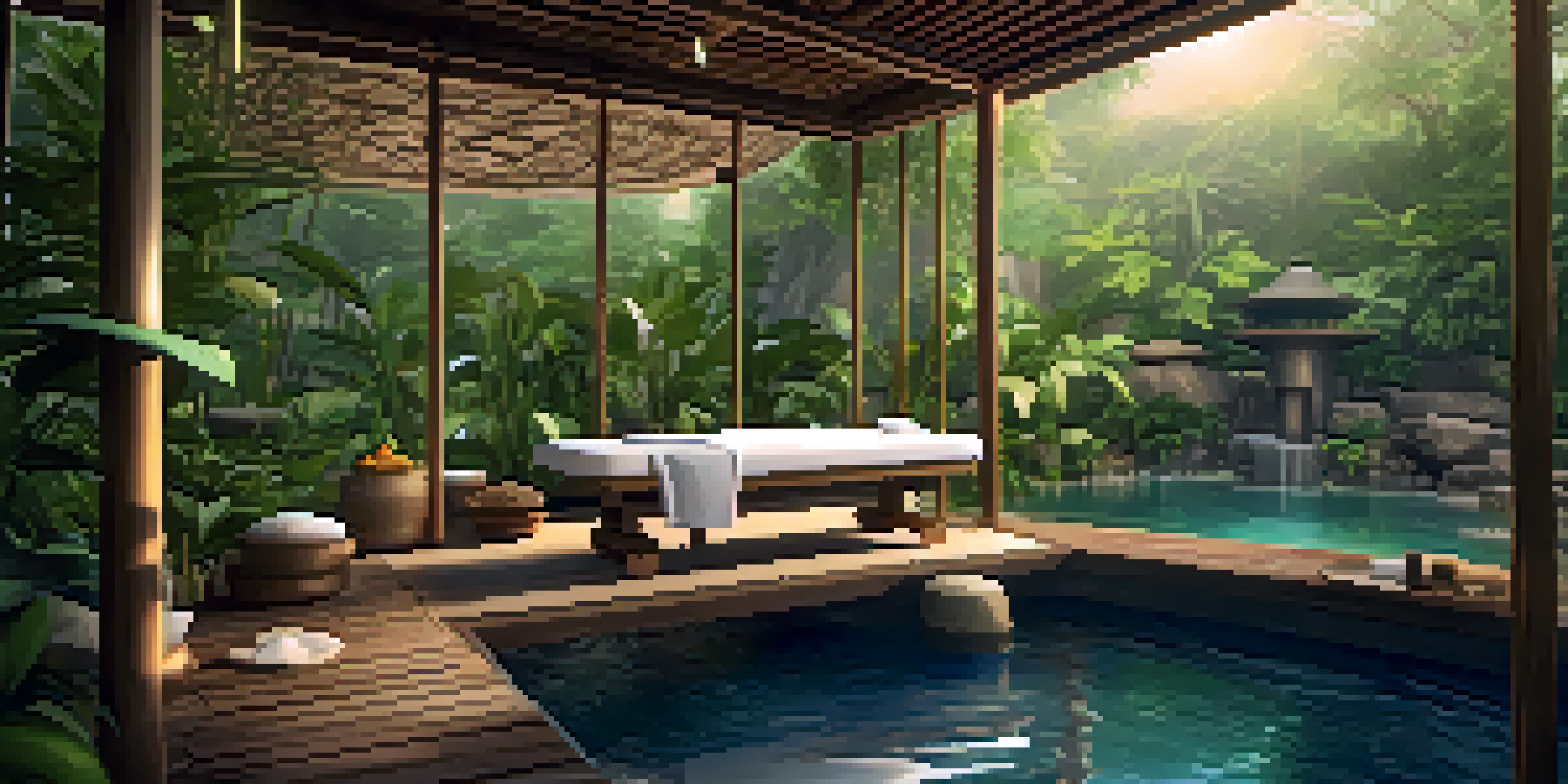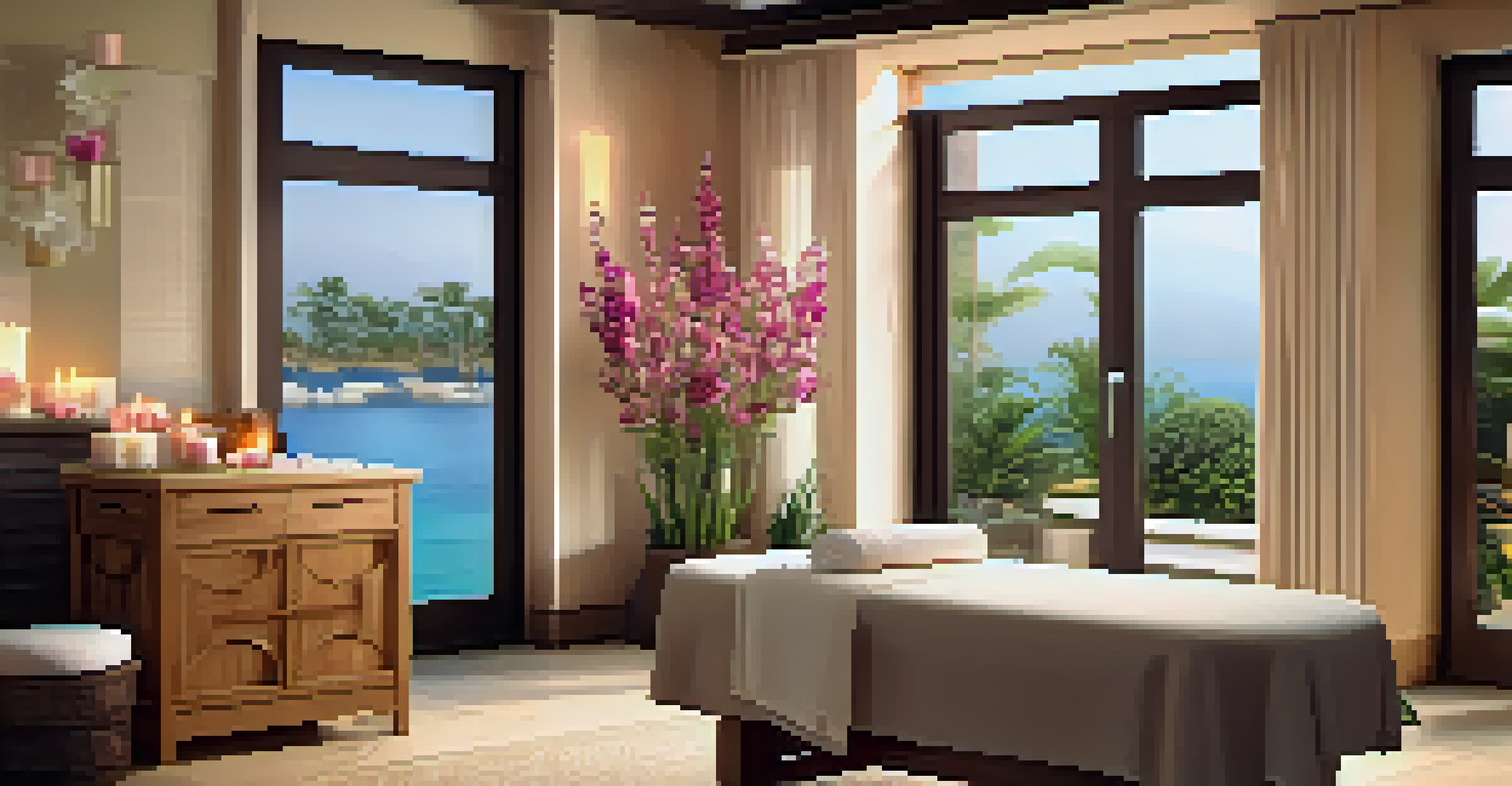The Impact of Wellness Tourism on Luxury Spa Trends

Understanding Wellness Tourism and Its Growth
Wellness tourism is a booming sector that combines travel with health and wellness experiences. It's not just about relaxation; it's about rejuvenating the mind, body, and spirit. This trend has gained momentum as more travelers seek meaningful escapes that enhance their overall well-being. With an increasing focus on self-care, wellness tourism is reshaping how people view vacations.
Travel is the only thing you buy that makes you richer.
In recent years, the global wellness tourism market has seen substantial growth, driven by a rising awareness of health and wellness benefits. According to various reports, this market is expected to continue expanding, appealing to a diverse audience, from busy professionals to wellness enthusiasts. As a result, luxury spas are adapting to meet the evolving demands of these travelers.
Understanding this growth helps luxury spas tailor their offerings to cater to wellness-focused tourists. By integrating wellness programs into their services, spas can create unique experiences that resonate with their clientele. This shift is not just beneficial for tourists; it also elevates the spa industry by promoting holistic health and well-being.
Key Trends in Luxury Spa Offerings
Luxury spas are transforming their services to align with the principles of wellness tourism. One prominent trend is the incorporation of holistic treatments that emphasize healing and balance. From aromatherapy to sound healing, these services aim to address both physical and mental well-being, attracting travelers seeking comprehensive wellness experiences.

Another emerging trend is the focus on local and organic products in spa treatments. Many luxury spas are now sourcing ingredients from their regions, ensuring that treatments are not only effective but also environmentally friendly. This practice resonates with travelers who prioritize sustainability and are keen to support local economies.
Rise of Wellness Tourism
Wellness tourism is rapidly growing as travelers seek health-focused experiences that rejuvenate the mind, body, and spirit.
Moreover, the fusion of wellness and technology is making waves in luxury spas. Innovative tools like biometric assessments and virtual wellness programs are becoming commonplace. These advancements not only enhance the luxury experience but also provide personalized insights, allowing guests to take their wellness journeys to the next level.
Personalization: A Key Element of Spa Experiences
Personalization is at the heart of the luxury spa experience, and it's becoming increasingly important in wellness tourism. Guests today expect tailored treatments that cater to their specific needs and preferences. As a result, luxury spas are investing in consultations and assessments to create bespoke wellness plans for their clients.
Wellness is not a destination, but a journey.
This tailored approach can include everything from customized facial treatments to personalized nutrition plans, making each visit unique. For example, a traveler might receive a specific massage designed to alleviate stress from long flights, or a skincare regimen that addresses their particular skin type. This level of attention to detail fosters a deeper connection between the guest and the spa.
Furthermore, personalization extends beyond treatments; it encompasses the overall experience. Luxury spas are now focusing on creating a nurturing environment, from the ambiance to the hospitality. This holistic approach ensures guests feel valued and cared for, enhancing their overall wellness journey.
The Role of Mindfulness in Spa Services
Mindfulness has emerged as a significant component of wellness tourism, and luxury spas are seamlessly incorporating it into their offerings. Techniques such as meditation and yoga are now commonplace in spa programs, allowing guests to cultivate a deeper sense of awareness and tranquility. This shift underscores the importance of mental health in the broader wellness dialogue.
By integrating mindfulness into spa services, luxury establishments are not just providing relaxation; they're offering transformative experiences. For instance, a spa might host guided meditation sessions or mindfulness workshops, helping guests reconnect with themselves. This approach appeals to travelers looking for more than just physical treatments; it addresses their emotional and spiritual well-being.
Personalization in Spa Services
Luxury spas are increasingly offering personalized treatments and experiences tailored to individual guest needs and preferences.
Moreover, this emphasis on mindfulness can enhance the effectiveness of traditional spa treatments. When guests enter a state of mindfulness, they are more receptive to healing and relaxation. This synergy between mindfulness and spa services is reshaping how luxury spas approach wellness tourism.
Integrating Nature into Wellness Experiences
Nature plays a pivotal role in wellness tourism, and luxury spas are embracing this connection. Many spas are now designed to harmonize with their natural surroundings, offering outdoor treatments and experiences that immerse guests in nature. This trend not only enhances relaxation but also fosters a sense of tranquility and rejuvenation.
For example, some luxury spas offer forest bathing or outdoor yoga sessions, allowing guests to connect with the environment. This practice acknowledges the therapeutic benefits of nature, helping individuals reduce stress and enhance their overall well-being. By bringing the outdoors in, spas create a holistic experience that resonates with wellness tourists.
Additionally, integrating nature into spa offerings can extend to the use of natural elements in design and treatments. This might include using local herbs and plants in spa rituals or designing spaces that maximize natural light and views. Such thoughtful integration creates an immersive experience that aligns beautifully with the principles of wellness tourism.
The Influence of Social Media on Spa Trends
In today's digital age, social media has become a powerful tool influencing wellness tourism and luxury spa trends. Platforms like Instagram and TikTok have made it easy for travelers to discover and share their wellness experiences, creating a ripple effect that shapes consumer expectations. This visibility drives spas to innovate continuously and offer unique, Instagram-worthy experiences.
For instance, spas are now curating visually stunning spaces and treatments that encourage guests to share their experiences online. From beautifully designed treatment rooms to vibrant, healthy cuisine, the goal is to create a feast for the eyes as well as the senses. This trend not only enhances the guest experience but also serves as a marketing tool for the spa.
Mindfulness and Nature Integration
Luxury spas are incorporating mindfulness practices and nature-based experiences to enhance overall wellness and tranquility for guests.
Moreover, the rise of influencers in the wellness space has further propelled this trend. Influencers often share their wellness journeys and spa experiences, inspiring their followers to seek similar experiences. As luxury spas adapt to this social media-driven landscape, they are becoming more creative in their offerings, ensuring they remain relevant and appealing to wellness tourists.
Future Directions for Luxury Spas in Wellness Tourism
As wellness tourism continues to evolve, luxury spas must stay ahead of the curve to meet the changing needs of travelers. One direction is the integration of wellness technology, such as wearables and apps that track health metrics. These tools provide guests with data to enhance their wellness journeys, making the spa experience more interactive and personalized.
Additionally, as more people prioritize mental health, luxury spas are likely to expand their offerings to include psychological wellness programs. This could involve partnerships with mental health professionals to provide workshops or therapies that address stress, anxiety, and overall emotional well-being. Such initiatives would position luxury spas as holistic wellness destinations.

Ultimately, the future of luxury spas in the realm of wellness tourism hinges on their ability to innovate while remaining true to core wellness principles. By fostering an authentic connection to well-being and adapting to emerging trends, spas can continue to thrive in this dynamic landscape, ensuring they meet the desires of modern travelers seeking transformative experiences.